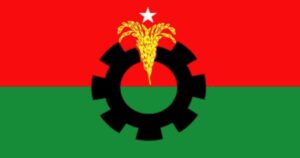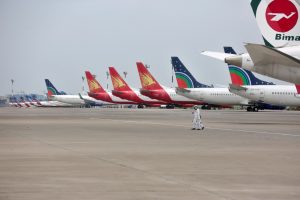Geneva, 4 Apr (D. Ravi Kanth) – China, in a tit-for-tat response to the unilateral crowbar trade measures being imposed by Washington on Chinese goods, signalled on Wednesday that it would slap tariffs on more than 100 American products in 14 categories, including some big-ticket items like soybeans, automobiles, and chemical products from the United States.In what appears to be a calibrated action, following a series of unilateral trade measures on imports from China, starting with steel and aluminum, announced by President Donald Trump to be followed by hefty duties on hi-tech imports from China, Beijing made it clear that its retaliatory actions will be assiduously based on various agreements of the World Trade Organization.
According to a news item in the CCTV (China Central Television), “China’s tariff commission of the State Council has decided to impose an additional tariff of 25% on 14 categories of 106 products such as soybeans, automobiles, and chemical products originating in the United States.”
China said the implementation date for imposing additional tariffs on American products will be “determined” by the implementation of the US government’s additional tariffs on Chinese products that the Trump administration announced on Tuesday.
An online statement issued by the Chinese finance ministry said: “America’s measures [for imposing additional tariffs on a range of Chinese hi-tech pro ducts] have violated the rules of the World Trade Organization, and have seriously violated China’s legal rights.”
China’s State Council signalled that it would impose additional tariffs of 25% on US products including soybeans, cars, and chemicals.
China also unambiguously made it clear that the additional tariffs to be imposed by China on American goods will be “in line with our rights and commitments under the WTO” and Chinese domestic law.
China singlehandedly has taken up the gauntlet to safeguard its exports as per the international trade rules at a time when other major trading nations such a s the European Union, Japan, Canada, and Australia among others remained silent i n the face of the unprecedented unilateral trade actions imposed by the Unite d States.
On Tuesday, the US Trade Representative Ambassador Robert Lighthizer made public the list of Chinese imports that will be subjected to additional tariffs on grounds of US determination of China’s unfair trade practices, in purported forced technology transfer by companies setting up shop in China and the alleged violation of intellectual property rights.
The US disclosed the long list of some 1,300 tariff lines that will be published in the Federal Register today (4 April).
The USTR said its actions are based on the investigations of Section 301 of US Trade law, that were carried out earlier in the year.
President Trump repeatedly threatened that, for the ostensible purpose of settling the trade deficit of more than US$350 billion with China, it will impose ta riffs on approximately $50 billion worth of Chinese imports and take other actions.
The USTR said, “These policies [such as forced technology transfer by the foreign companies] bolster China’s stated intention of seizing economic leadership in advanced technology as set forth in its industrial plans, such as Made in China 2025.”
According to Ambassador Lighthizer, the targeted list of Chinese products which, he said, are being supported and subsidized by the Chinese authorities, will have minimum impact on the US economy.
According to a report in Washington Trade Daily on 4 April, the Chinese “sectors subject to the proposed tariffs include industries such as aerospace, information, and communication technology, robotics and machinery.”
“The list covers approximately 1,300 separate tariff lines and will undergo further review in a public notice and comment process, including a hearing set for May 15,” the WTD said.
“After completion of the process, USTR will issue a final determination on the products subject to the additional duties [and] the total value of imports subject to the tariff increase is commensurate with an economic analysis of the harm caused by China’s unreasonable technology transfer policies to the US economy, as covered by USTR’s Section 301 investigation,” the USTR stated, according to WTD.
Last week, the US invoked dispute settlement proceedings against China at t he WTO, saying Beijing’s continued discriminatory policies aimed at mandatory technology transfer by foreign companies to Chinese entities violate global trade rules.
In all probability, the US will ask for the establishment of a panel to adjudicate over the issues it raised in the dispute on IPR violations by China.
So far, the WTO’s trade law has not been tested in cases of alleged technology transfer as demanded by host countries.
Perhaps, the latest US dispute against China is going to be the first of it s kind.
[According to a post and comments at the IELP blog, while the forced techno logy transfer issue is in violation of the Chinese accession protocol and the terms of the WTO working party on the Chinese accession (and hence needing a WTO DSU determination of Chinese violation), the US problem has been that the Chine se actions and conditions to allow investments and access to markets have been oral and not easy to prove before a dispute panel. SUNS]
Last week (26 March), China’s trade envoy to the WTO, Ambassador Zhang Xiangchen, warned: “the unilateral action of the US Section 301 investigations will not only impair the rights and interests of China and other WTO Member s, but also seriously undermine the multilateral trading system.”
Ambassador Zhang said, “Section 301 investigations and measures are purely unilateral which are per se prohibited by Article 23 of the DSU, and violate the most fundamental values and principles of this organization.”
He said according to “WTO rulings and the US commitment, the US shall by no means determine unilaterally based on a S.301 investigation that other Members have violated the WTO rules.”
“When it comes to matters related to the WTO Agreements, the US shall strictly abide by the WTO rules and findings of the DSB.”
Therefore, “what US has done contradicts the commitments that the US had “explicitly, officially, repeatedly and unconditionally confirmed” before t he Panel in DS152 (the dispute raised by the EU against the US in 1998), that the USTR would base a Section 301 decision only on adopted DSB findings,” the Chines e envoy said.
The panel in DS152 (taking note of the US statements before it on the US obligations vis-a-vis US S.301 family of laws and US commitments in signing on to the WTO treaty) in its ruling had also warned that “should the US repudiate or remove in any way these undertakings, the US would incur state responsibility since its law would be rendered inconsistent with the obligations under Article 23,” Ambassador Zhang argued.
“We have seen in the history that, for a long period of time, the US has frequently launched unilateral investigations on trade and economic policies of other countries or regions, and implemented retaliation and sanctions such as raising tariffs and restricting investment for reasons of domestic industries’ protection,” he said.
“Since 1974, the US has launched 125 Section 301 investigations, which affected almost all the Members,” China’s trade envoy said, arguing that “the unilateral measures of US Section 301 had been ceased after the establishment of WTO.”
“However, upon this time, the US is setting a very bad precedent by bluntly breaching its commitment made to the world.”
“WTO members should jointly prevent the resurrection of 301 investigations and lock this beast back into the cage of the WTO rules,” China’s trade envoy emphasized.
He cautioned the US that China remains fully prepared to “react to the conclusions and measures of Section 301 by the US, and will firmly take the WTO rules and other necessary ways to safeguard its legitimate rights and interests.”
Ambassador Zhang admitted that “undoubtedly, China is facing a tough test, and we’re prepared for the difficulties ahead.”
“If someone asks what the character of the Chinese people is, I’d say that it is like a bamboo, resilient enough to dance in the wind, but strong enough to withstand tremendous pressure,” the Chinese envoy said.
“Unilateralism is fundamentally incompatible with the WTO, like fire and water,” Ambassador Zhang maintained.
“In the open sea, if the boat capsizes, no one is safe from drowning. We shouldn’t stay put watching someone wrecking the boat. The WTO is under siege and all of us should lock arms to defend it,” he argued.
China has circulated a list of US imports worth some $3 billion that will be subject to retaliatory tariffs because of Washington’s allegedly illegal safeguard measures on steel and aluminium based on “national security” considerations.
In a notification submitted to the World Trade Organization’s Council for Trade in Goods last week, China said the US measures imposed in the name of “national security” are not consistent with its obligations under GATT 1994 and the Safeguards Agreement.
Beijing maintained that the suspension of concessions under Article 8.2 of the Safeguards Agreement takes the form of an increase in tariffs on the US pro ducts based in part because the measures were not taken as a result of an absolute increase in imports over three years – 2014 to 2016.
China also said it reserves the right to impose further retaliatory measures.
In a separate development concerning its safeguard measures on crystalline silicon photovoltaic cells from China, the United States shared information on its consultations with Beijing on February 12.
Washington said it will continue discussions.
China stated that Washington did not act in conformity with Article 8.1 of the Safeguards Agreement and has an obligation to compensate China.
The United States, it added, will have to make compensation “regardless of the legality of the measure.”
Beijing maintained that it has the right to impose retaliatory measures on US imports because the measures on its photovoltaic cells were not taken as a result of an absolute increase in imports or in conformity with the provisions of the Agreement.
Significantly, the Northern countries – the European Union, Japan, Canada, and Australia – are aligning with the US even though Washington is resorting to alleged unilateral actions.
It remains to be seen whether all Southern countries can or will rally round China in its fight against the global trade hegemon. Published in SUNS #8655 dated 5 April 2018. – Third World Network




